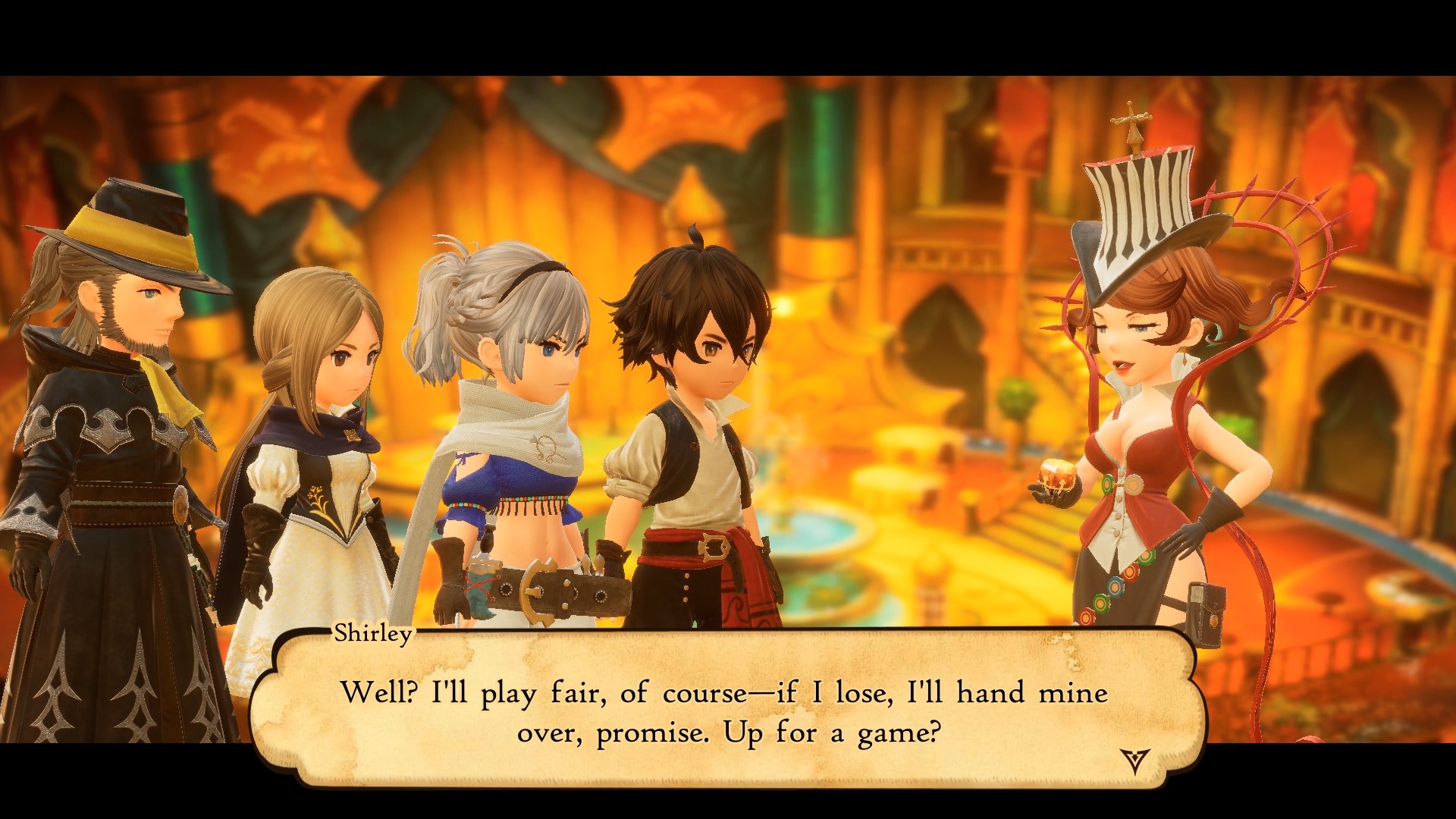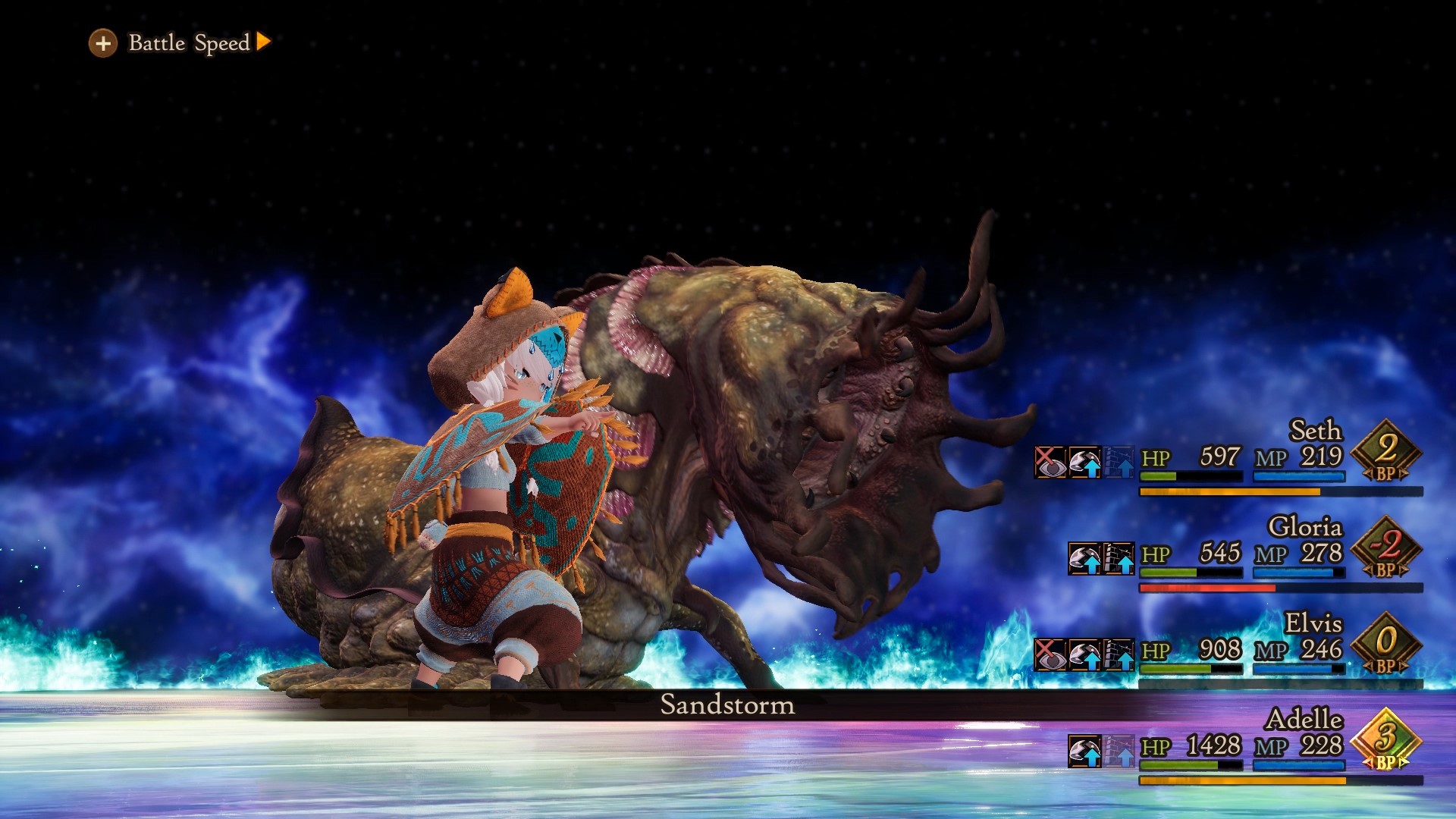[Review] Bravely Default II
System: Switch
Release date: February 26, 2021
Developer: Square Enix / Claytechworks
Publisher: Nintendo
It’s hard for me to reflect on the 3DS without thinking about the fond memories I’ve had playing Bravely Default, spending over 150 hours to fully complete everything the game had to offer – from getting all jobs and characters to max levels, to seeing credits roll, completing all dungeons and sidequests, and just about everything until my cartridge became no more than a paperweight by the end of it all. It was a part of the genre I had so deeply missed, and while I love the innovation and how far role-playing games have comes since the days of Final Fantasy Adventures and Chrono Trigger, sometimes you can’t help but “go back to the basics” to a simpler time where you could strategize more, form a party of warriors and mages, and go on a fantastical adventure. Now with the power of Unreal Engine 4, Bravely Default II looks as beautiful as ever, as your party of four shines in battle with a more 3D-esque approach compared to its predecessors, yet still retaining its artistic integrity and stunning environmental design. The series’ Switch debut is a massive leap forward for the series on both a mechanical and technical level, even if there are some tweaks made this time around that may or may not be questionable to those who have played the entries before it.
Unlike Bravely Default and Bravely Second where players got to see life through the eyes of Tiz and Yew respectively, Bravely Default II has the player giving a name for the protagonist to make things more personable, though there’s no character customization. The protagonist is very much set-in-stone fully equipped with a look, voice, and storyline outside of namesake. You’ll join Princess Gloria, Elvis, and Adelle, as you recover the lost crystals set in a brand new world with a new cast of characters, meaning anyone can jump into looking for a one-of-a-kind experience while keeping the innovation and level of nostalgia from prior games to keep thing fresh yet familiar in an artful way.

Its outstanding battle system stays intact, providing the same name as its title as its Bravely and Default systems allow for both extended attacks and BP gains to unleash a flurry of strikes without having to sacrifice turns respectively. Much like the previous Bravely titles, it keeps the gameplay addictive and strategic while also giving a sense of high risk and high reward as your BP (or Brave Points) build and are expended to unleash huge amounts of damage on a single or multiples foes. To make things more accessible within its battle system, you can also increase the speed of which that battles play out, which can be helpful to those that may not have the luxury of time to play a very lengthy RPG like Bravely Default II.
Features like this make a comeback from prior installments to carry on the essence of the Bravely series, though there are some obvious – and some drastic – changes that, for better or for worse, certainly put Bravely Default II into a league of its own. One of the most appreciated features of the prior installments was the enemy slider that allowed for either up to +100% more enemy spawns or -100% which would rid of enemies entirely. It’s something that, to this day, I haven’t seen in any other game, which is ridiculous to me because it’s always been one its standout features I wish RPGs had more of to tune the frequency of battles to your liking. Being able to grind with just about every step initiating an encounter on top of the fact that you can increase the battle speed up to four times faster made it so it was possible to get to higher levels and acquire more job points in just about no time at all, but, conversely, you could also reduce the amount of enemies that would show up during your time up to completely negating battles all together. For some odd reason, this has been omitted in Bravely Default II, presumably due to the fact that enemies now appear in the overworld rather than randomized battles that occur as you’re walking, so if you didn’t want to battle you could just simply walk past them. However, some are hard to avoid due to terrain obstacles or the ones that chase after you are faster than you’d expect.

Job combinations are introduced in Bravely Default II to allow for more strategic stat differentials that go up and down depending on the combination of your main job and its associated skills along with your sub job, which effectively gives you another layer of skills tied to that class to use in battle. Utilizing both is extremely helpful when you really want to go for big boosts in certain areas of your stats or if one is just naturally low for a particular character. They’re incredibly useful, and with how hard the game is at certain parts regardless of what difficulty you find yourself in, you’ll want to play around with these combinations as you go to best fit your playstyle and battle strategy. It’s a welcoming system that provides more overall depth, and with the multitude of classes, it’s nice to be able to utilize more than one, as I frequently found myself bouncing back and forth between a bunch of them, especially during certain environments where some elementals and skillsets were more advantageous than others. Being able to now take advantage of two skillsets during battle without having to switch as much is a great way to add more flexibility while out on the battlefield where you can have any number of enemies with a wide-range of effectiveness – sometimes back to back, as battles that are initiated close by other enemies will make for consecutive bouts, and, while difficult, can also reap in huge rewards.
The battle system feels a lot more fleshed out, and with Bravely Default II being developed with Unreal Engine 4, the series is as beautiful as it has ever been with monsters featuring tremendous detail and shine to really pop. It’s inspired by the usual animalistic designs such as spiders, snakes, hogs, and more, while also having more mythical and sentient monsters that may represent levitating shapes or elemental magic. Unfortunately, for the big leap in its graphics compared to its predecessors on 3DS, there are some minor hiccups that tend to occur from time to time, though it’s nothing that takes away from the experience. I’ve found stutters and tears while attempting to open up the menus or beginning battles, occasional frame drops while walking in the overworld, and even the random screen tear by turning the camera in certain angles. Odd little freezes will happen in conversational cutscenes at sporadic times, and unfortunately I feel there’s more loading than there should be as you go in and out of cities, though fast travelling makes sense. Thankfully, you can just walk in and out of a building and room seamlessly by just walking past the door – no button press needed.

Other than those little hiccups, it’s never truly bothersome, though I feel a lot of the time in both handheld and TV modes, the game visually could be a little more fleshed out, as once again this is another published title where anti-aliasing is nothing more than a myth, and resolution is lower than what is natively available in busier scenes. In addition to this, due to the graphical and technical prowess of Bravely Default II, video capture is not possible. Something tells me this is more so for the fact to avoid spoilers since Bravely Default II – as well as the Bravely entries before it – are narrative-heavy, with cutscenes and dialogue happening in just about every corner, as well as Party Chats that intermittently show up where the group will talk amongst themselves. One could surmise that this is mainly to avoid spoilers more so than a technical disability.
Despite some of the technical hurdles, Bravely Default II seems to be a lot more palatable with a story that’s not nearly as complex as its predecessors, and instead relies on what feels like having a series of short stories within each town, kingdom, and set of bosses that make up a greater whole as you restore order back within Excillant and its multiple kingdoms from an evil called the Night’s Nexus. In true JRPG fashion, the experience will take upwards of 100 hours of playtime, but a big part of its accessibility aside form the items mentioned earlier is that while in sleep mode, if enabled, you can set out a ship for exploration that will go and scavenge surrounding islands for up to 12 hours. For those that may not have much time available to them, players can still make some sort of progress with the items bestowed upon them from these travels that can apply permanent stat boosts, Job boosts, and level boosts without having to go into a single battle. Obviously things would naturally progress quicker to grow as you play, but it’s a nice little side chain that works alongside you whenever you’re not on your Nintendo Switch. Keep in mind that the feature works exclusively in sleep mode, so turning the game off outright or closing the application to play something else won’t cause the exploration to progress.

The music helps accentuate all of these intense and dramatic moments Bravely Default II puts you in, with compositions returning from Revo, and I couldn’t help but notice lots of beautifully orchestrated pieces that are filled with massive crescendos and anthemic martial tones, and it’s incredible how well it all fits while still retaining that signature Bravely Default sound that I feel the game simply couldn’t ever work as well without. From your special attacks that all of a sudden hit you with flamencos that not only power you up but make you want to dance, to the boss battles that fuel an almost gargantuan war of bravery and might through your body, all the way to the cultural tones from city to city, Bravely Default wouldn’t stick out anywhere near as much without its accompanying score to aid the heroes on their quest for restoration; it’s yet another reason to keep coming back to its fantastical and adventurous narrative.
Bravely Default II is a big step in the right direction for the series as it continues to grow and utilize new hardware, but one of the most disappointing things I feel is that the cast and crew, while great in their own respect, don’t have that same charisma we saw from the characters in Bravely Default and Bravely Second. It’s possible that sometimes the voices, while well done, seem to not fit certain characters more than others. At the same point I was halfway through the game in Bravely Default/Second as I was in Bravely Default II, I was emotionally invested in the characters and the world. I was also invested in Bravely Default II, but it just doesn’t have that same sort of panache that previous titles did, despite it being a big step forward. It’s possible the more stylized and unique art direction featured in the series’ previous entries versus the more shiny and extremely detailed nature of Unreal Engine 4 takes away some of the charm. By now I would have gone through just about every emotion such as laughing, tearing up, getting angry, or feeling worried, and while I’ve laughed a few times and the characters are most certainly likeable, it feels more like a road trip between a new age of Heroes of Light rather than a bonding and growth of love and comradery. There are elements, sure, but it’s not nearly as palpable this time around, though it’s all enjoyable nonetheless and remains a top-notch RPG.
The Verdict
While I felt Bravely Default and Bravely Second: End Layer before it were unique RPG experiences that some could consider masterpiece and future classics, Bravely Default II takes whatever flaws there were in prior installments either due to hardware limitations or odd ideas, and polishes them up for what is yet another excellent follow-up. The new Switch game continues to respect the foundations of what popularized turn-based RPGs while keeping things fresh and exciting for both newcomers and veterans alike. Additionally, with it taking more of a Final Fantasy approach with its standalone story, world, and characters, players that may not have had the chance to experience the classics on 3DS will be welcomed to a beautiful world where the crystals once again need to be defended, all while experiencing relationships both wholesome and nefarious for a wild ride of emotion, valor, and sheer excellency. Bravely Default II continues to show that the series is here to stay and leave a mark with a quality that can’t be matched, while simultaneously proving that Square Enix’s internal and external teams have shown no sign of wear and tear even after decades of traditional turn-based RPGs.
Review copy provided by the publisher for the purposes of this review.
![[Review] Bravely Default II](https://nintendoeverything.com/wp-content/uploads/bravely-default-ii-review-656x369.jpg)
